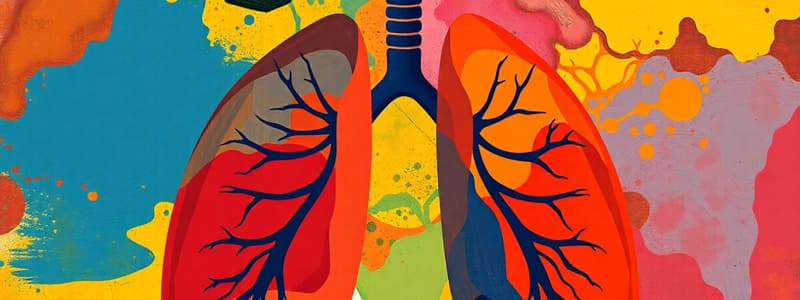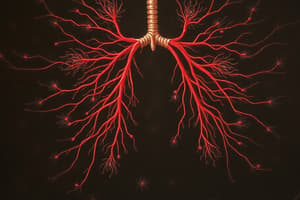Podcast
Questions and Answers
What is the primary purpose of external respiration?
What is the primary purpose of external respiration?
- Energy production in cells.
- Movement of gases within the body.
- Movement of gases between the environment and the body’s cells. (correct)
- Intracellular reactions of glucose.
The larynx is responsible for filtering air from large particles.
The larynx is responsible for filtering air from large particles.
False (B)
What is produced during cellular respiration?
What is produced during cellular respiration?
Energy (ATP), CO2, and water.
The process that transports oxygen and carbon dioxide by the blood is called _____
The process that transports oxygen and carbon dioxide by the blood is called _____
Match the following parts of the respiratory tract with their functions:
Match the following parts of the respiratory tract with their functions:
Which statement correctly describes the conducting zone of the airways?
Which statement correctly describes the conducting zone of the airways?
The primary bronchi are completely flexible tubes.
The primary bronchi are completely flexible tubes.
Identify the four processes involved in external respiration.
Identify the four processes involved in external respiration.
The _____ are connective tissue bands in the larynx that create sound.
The _____ are connective tissue bands in the larynx that create sound.
Which of the following structures is NOT part of the upper respiratory tract?
Which of the following structures is NOT part of the upper respiratory tract?
What is the primary purpose of the conducting airways?
What is the primary purpose of the conducting airways?
The respiratory zone is responsible for the majority of gas exchanges in the lungs.
The respiratory zone is responsible for the majority of gas exchanges in the lungs.
What is the approximate volume of the conducting airways?
What is the approximate volume of the conducting airways?
The last 7 airway divisions are part of the __________ zone.
The last 7 airway divisions are part of the __________ zone.
Match the following functions of the airways with their descriptions:
Match the following functions of the airways with their descriptions:
What occurs when air reaches the terminal bronchioles?
What occurs when air reaches the terminal bronchioles?
The conducting airways are involved in gas exchange.
The conducting airways are involved in gas exchange.
What is the main mechanism of air flow in the respiratory zone?
What is the main mechanism of air flow in the respiratory zone?
Inhaled medium-sized dust particles (1-5μm) often settle out in the __________ bronchioles.
Inhaled medium-sized dust particles (1-5μm) often settle out in the __________ bronchioles.
According to the Weibel model, how many airway divisions compose the conducting zone?
According to the Weibel model, how many airway divisions compose the conducting zone?
What is the primary function of the mucus layer in the respiratory system?
What is the primary function of the mucus layer in the respiratory system?
The cilia in the trachea and bronchi help to move mucus towards the lungs.
The cilia in the trachea and bronchi help to move mucus towards the lungs.
What are the small air sacs in the lungs that facilitate gas exchange called?
What are the small air sacs in the lungs that facilitate gas exchange called?
The two systems that comprise the blood-gas barrier are the __________________ and the circulatory system.
The two systems that comprise the blood-gas barrier are the __________________ and the circulatory system.
Match the following cell types with their functions:
Match the following cell types with their functions:
What role does stomach acid play after mucus is swallowed?
What role does stomach acid play after mucus is swallowed?
Alveoli have cilia to help in trapping foreign particles.
Alveoli have cilia to help in trapping foreign particles.
What is the process called where cilia move mucus towards the pharynx?
What is the process called where cilia move mucus towards the pharynx?
The primary environmental threats to the alveoli are viruses, bacteria, and __________________ particles.
The primary environmental threats to the alveoli are viruses, bacteria, and __________________ particles.
What is the primary function of alveoli?
What is the primary function of alveoli?
Flashcards
Cellular Respiration
Cellular Respiration
The intracellular reaction where oxygen and glucose combine to produce energy (ATP), carbon dioxide, and water.
External Respiration
External Respiration
The exchange of gases between the environment and the body's cells.
Ventilation
Ventilation
Air exchange between the atmosphere and the lungs, also known as breathing.
Gas Exchange (lungs)
Gas Exchange (lungs)
Signup and view all the flashcards
Gas Transport
Gas Transport
Signup and view all the flashcards
Conducting Zone
Conducting Zone
Signup and view all the flashcards
Terminal Bronchioles
Terminal Bronchioles
Signup and view all the flashcards
Upper Respiratory Tract
Upper Respiratory Tract
Signup and view all the flashcards
Lower Respiratory Tract
Lower Respiratory Tract
Signup and view all the flashcards
Larynx
Larynx
Signup and view all the flashcards
Anatomic Dead Space
Anatomic Dead Space
Signup and view all the flashcards
Respiratory Zone
Respiratory Zone
Signup and view all the flashcards
Conducting Airways
Conducting Airways
Signup and view all the flashcards
Alveoli
Alveoli
Signup and view all the flashcards
Terminal Bronchioles
Terminal Bronchioles
Signup and view all the flashcards
Respiratory Bronchioles
Respiratory Bronchioles
Signup and view all the flashcards
Alveolar Ducts
Alveolar Ducts
Signup and view all the flashcards
Acinus
Acinus
Signup and view all the flashcards
Air warming
Air warming
Signup and view all the flashcards
Air moistening
Air moistening
Signup and view all the flashcards
Air Filtration
Air Filtration
Signup and view all the flashcards
Mucociliary Escalator
Mucociliary Escalator
Signup and view all the flashcards
Blood-Gas Barrier
Blood-Gas Barrier
Signup and view all the flashcards
Alveoli
Alveoli
Signup and view all the flashcards
Macrophages
Macrophages
Signup and view all the flashcards
Capillaries
Capillaries
Signup and view all the flashcards
Gas Exchange
Gas Exchange
Signup and view all the flashcards
Trachea and Bronchi
Trachea and Bronchi
Signup and view all the flashcards
Goblet Cells
Goblet Cells
Signup and view all the flashcards
Cilia
Cilia
Signup and view all the flashcards
Study Notes
Respiration
- Respiration is divided into cellular and external respiration
- Cellular respiration is the intracellular reaction of oxygen and glucose to produce carbon dioxide, water and energy (ATP)
- External respiration involves four processes: ventilation/breathing (air exchange between atmosphere and lungs), gas exchange (oxygen and carbon dioxide between lungs and blood), transport (oxygen and carbon dioxide transport in blood), and gas exchange (oxygen and carbon dioxide between blood and cells)
The Respiratory Tract
- The respiratory tract is divided into upper and lower parts
- The upper respiratory tract includes the mouth, nasal cavity, pharynx, and larynx
- Mouth: allows air to enter the system
- Nasal cavity: filters air from large particles
- Pharynx: common passageway for food, liquid and air
- Larynx: contains vocal cords that vibrate to create sound as air passes through
The Lower Respiratory Tract
- Includes trachea, primary bronchi, branches of bronchi, and lungs
- Trachea: semi-flexible tube made of 15-20 C-shaped cartilage rings
- Primary bronchi (x2): semi-rigid tubes supported by cartilage
- Branches of bronchi: further divisions within the lungs
- Lungs: the primary organs for gas exchange
Airways
- Airways narrow, shorten and become more numerous as they get deeper into the lungs
- Divided into two zones: conducting and respiratory zones
- Conducting zone: leads inspired air to the gas-exchanging regions of the lung. These lack alveoli and do not participate in gas exchange. The trachea branches into right and left main bronchi, which then divide into lobar, then segmental, then terminal bronchioles. The anatomic dead space is approximately 150 ml.
- Respiratory zone: region of the lung where gas exchange occurs. It begins with terminal bronchioles, which branch into respiratory bronchioles that have alveoli budding from their walls. Respiratory bronchioles continue into alveolar ducts (lined with alveoli) and then alveolar sacs. The respiratory zone makes up most of the lung (volume ~2.5-3L during rest)
Function of Airways
- Passage for air to reach alveoli
- Air conditioning: warming, moistening and filtering incoming air (involves 3 steps):
- Air warming: warms air to body temperature (37°C)
- Air moistening: reaches 100% humidity from water evaporation from the mucosal lining
- Air filtration: removes foreign particles (viruses, bacteria, and inorganic particles) using cilia and mucus
Alveoli
- Small air sacs covered with capillaries that form the blood-gas barrier
- Each alveolus is made up of a single layer of epithelium with two cell types:
- Type I alveolar cells: very thin cells for gas diffusion (95% of alveolar surface area)
- Type II alveolar cells: secrete surfactant (5% of alveolar surface area) to reduce surface tension and prevent lung collapse
- The thin blood-gas barrier allows for efficient gas exchange
Pulmonary Circulation
- Low-oxygen blood passes from the right ventricle to the pulmonary artery, then divides into capillaries at the blood-gas barrier
- Capillaries join to form the pulmonary vein which returns oxygenated blood to the left atrium
- The capillary network in alveoli walls is dense and efficient for gas exchange (RBCs spend ~0.75 seconds)
- Pulmonary blood pressure is low (about 15 mmHg) due to short length and low resistance of vessels
- The blood-gas barrier is very thin (0.3 µm) and has high surface area
- It consists of layers: surfactant, epithelial cell, interstitial space, endothelial cell, plasma, red blood cell membrane
Functions of the Respiratory System
- Gas exchange
- Regulation of body pH
- Thermoregulation
- Protection from inhaled pathogens
- Filtration of blood (small blood thrombi)
- Metabolism (e.g. of Angiotensin)
- Blood reservoir
- Olfaction
- Speech production
Studying That Suits You
Use AI to generate personalized quizzes and flashcards to suit your learning preferences.




